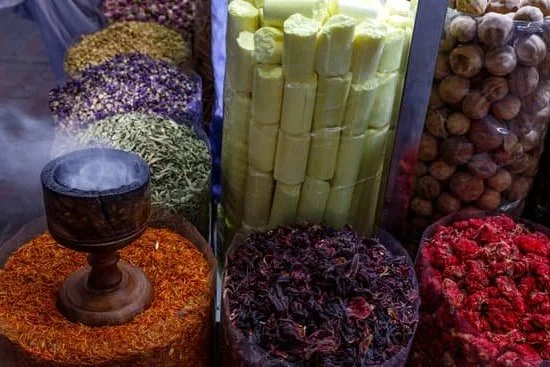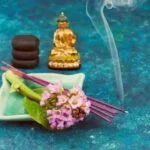Aromatherapy is a holistic healing treatment that uses natural plant extracts, known as essential oils, to promote physical and mental well-being. These potent oils are extracted from various parts of plants and have been used for centuries for their therapeutic properties.
When it comes to incorporating essential oils into aromatherapy, one common question that arises is, how much essential oils last for aromatherapy? It’s important to understand the shelf life of these oils and how to maximize their longevity for optimal aromatic benefits.
High-quality essential oils are vital for effective aromatherapy. Their purity and potency play a significant role in achieving the desired therapeutic effects. Understanding the factors that affect the shelf life of essential oils is crucial in maintaining their quality. Proper storage also plays a key role in extending their lifespan.
Different types of essential oils have varying lifespans when it comes to aromatherapy. Some oils can maintain their aroma and therapeutic properties for years, while others may deteriorate more quickly. Recognizing when an essential oil has expired and is no longer suitable for aromatherapy is important in ensuring safe and effective use.
In this article, we will delve into the world of essential oils and aromatherapy, exploring how to estimate the lifespan of essential oils for aromatherapy purposes and providing tips on maximizing their use. Additionally, we will discuss the art of blending essential oils for extended use, choosing the right oils for longevity, as well as techniques for revitalizing expired essential oils. Let’s explore how we can make the most of essential oils for aromatherapy while enhancing their lifespan.
Understanding the Shelf Life of Essential Oils
When it comes to aromatherapy, the quality and longevity of essential oils play a crucial role in ensuring an effective and satisfying experience. Understanding the shelf life of essential oils is essential for maximizing their potential benefits. Several factors can affect the shelf life of essential oils, including exposure to light, air, heat, and moisture. It is important to store essential oils properly to extend their shelf life and preserve their therapeutic properties.
Factors Affecting Shelf Life
The shelf life of essential oils can vary depending on several factors. Exposure to sunlight and heat can cause essential oils to degrade more quickly, leading to a shorter lifespan. Additionally, oxygen and moisture can also impact the chemical composition of essential oils, affecting their aroma and effectiveness. High-quality essential oils that are properly stored in dark glass bottles in a cool, dry place have the potential to last longer compared to those exposed to unfavorable conditions.
Proper Storage Methods
To ensure the longevity of essential oils for aromatherapy purposes, it is crucial to store them properly. Essential oils should be kept in dark-colored glass bottles with tight-fitting caps to protect them from light exposure. Storing the bottles in a cool and dark place away from direct sunlight or heat sources can help maintain their potency.
Additionally, keeping the bottle tightly closed when not in use can prevent oxygen from entering and causing oxidation. By following these storage guidelines, individuals can maximize the shelf life of their essential oils for aromatherapy.
Revitalizing Expired Essential Oils
In some cases, essential oils may reach their expiration date or lose their potency due to improper storage or prolonged exposure to unfavorable conditions. However, there are techniques for revitalizing expired essential oils for continued use in aromatherapy.
DIY methods such as blending aging or expired essential oils with fresh ones can help restore their aromatic properties and extend their lifespan for aromatic benefits. By utilizing these revitalization methods, individuals can make the most of their essential oil collection while minimizing waste.
Estimating the Lifespan of Essential Oils for Aromatherapy
When it comes to estimating the lifespan of essential oils for aromatherapy, it’s important to consider that each type of essential oil has its own shelf life. The lifespan of essential oils can vary depending on factors such as the type of oil, how it is stored, and whether it is a single oil or part of a blend.
It’s also crucial to note that the quality of the essential oil plays a significant role in how long it will last for aromatherapy purposes.
Specific Essential Oils and Their Average Lifespan for Aromatherapy
Different essential oils have different shelf lives. For example, citrus oils like lemon and orange tend to have a shorter shelf life of around 1-2 years. On the other hand, oils like lavender and patchouli can last anywhere from 4-6 years. It’s important to check the specific shelf life of each essential oil you use for aromatherapy, as some may have longer or shorter lifespans than others.
How to Recognize if an Essential Oil Has Expired
One way to determine if an essential oil has expired is by checking its aroma and appearance. If an essential oil smells off or has changed in color, it may have oxidized and is no longer suitable for aromatherapy.
Additionally, if an essential oil causes irritation when applied to the skin, it may have gone bad. Keeping track of the purchase date and labeling your bottles with expiration dates can also help you recognize when an essential oil is no longer suitable for use in aromatherapy.
Understanding the specific lifespan of each essential oil and being able to recognize signs of expiration are crucial in ensuring that you are using high-quality oils for your aromatherapy practice. By selecting oils with longer lifespans and properly storing them, you can maximize their aromatic benefits and extend their usability for your wellness routines.
Maximizing the Use of Essential Oils
When it comes to getting the most out of your essential oils for aromatherapy, there are several tips and tricks that can help prolong their lifespan. One important factor to consider is the quality of the essential oil. High-quality, pure essential oils generally have a longer shelf life compared to oils that have been diluted or contain synthetic additives. It’s also essential to store essential oils properly in order to extend their longevity.
Proper storage is crucial in maximizing the use of essential oils. The shelf life of essential oils can be affected by various factors such as exposure to light, air, and heat. To preserve their potency, it’s recommended to keep essential oils in dark glass bottles and stored in a cool, dark place. This helps protect them from degradation caused by exposure to external elements.
Another way to make the most out of your essential oils is by using them efficiently. Just a few drops of high-quality essential oil can go a long way in aromatherapy. Diluting them with a carrier oil or water before use can also help stretch their usage while still providing effective aromatic benefits.
It’s also worth mentioning that certain types of essential oils have longer lifespans than others due to their chemical composition and properties. For example, citrus oils like lemon and orange tend to have shorter shelf lives compared to floral or woody oils such as lavender or cedarwood. Being mindful of these differences can help you choose the right essential oils for longevity when incorporating them into your aromatherapy practices.
| Essential Oil | Average Lifespan for Aromatherapy |
|---|---|
| Lemon | 1-2 years |
| Lavender | 2-3 years |
| Cedarwood | 4-5 years |
Choosing the Right Essential Oils for Longevity
When it comes to selecting essential oils for aromatherapy, it’s important to consider their longevity and shelf life. Choosing the right essential oils can ensure that you get the most out of your aromatherapy experience. Here are some tips for choosing essential oils that will provide lasting benefits for aromatherapy:
- Opt for citrus oils: Citrus essential oils such as lemon, lime, and grapefruit are known for their long-lasting aroma. These oils not only offer a refreshing scent but also have uplifting and energizing properties, making them ideal for use throughout the day.
- Explore woody scents: Essential oils derived from wood such as cedarwood, sandalwood, and pine tend to have a longer shelf life compared to other types of essential oils. These earthy scents can bring a sense of grounding and calmness to your aromatherapy sessions.
- Consider floral options: Certain floral essential oils like lavender, chamomile, and rose are known for their longevity and soothing properties. These oils can promote relaxation and help create a serene atmosphere during aromatherapy practices.
In addition to choosing specific types of essential oils known for their long-lasting aroma, it’s also important to prioritize high-quality products. Look for reputable brands that offer pure and natural essential oils free from synthetic additives or fillers. Investing in quality essential oils can contribute to their extended lifespan and overall effectiveness in aromatherapy.
Ultimately, taking the time to research and select the right essential oils for longevity can enhance your aromatherapy experience and ensure that you get the most out of each oil’s therapeutic benefits.
Keywords: how much essential oils last for aromatherapy
Blending Essential Oils for Extended Aromatherapy Use
When it comes to using essential oils for aromatherapy, blending different oils can not only create unique scents but also help extend their use. By combining essential oils with complimentary properties and aromas, you can create blends that have a longer-lasting scent and maximize the benefits for aromatherapy. Here are some tips for blending essential oils for extended aromatherapy use:
- Understand the properties of each essential oil: Before blending essential oils, it’s important to understand the individual properties of each oil. Some oils have strong scents that can overpower others, while some have specific therapeutic benefits that can enhance the overall blend.
- Use a proper carrier oil: Mixing essential oils with a carrier oil not only dilutes the potency but also helps in extending their use. Carrier oils like jojoba, sweet almond, or coconut oil can act as a base for your essential oil blends and help them last longer when used in aromatherapy.
- Consider the top, middle, and base notes: When creating an essential oil blend for aromatherapy, it’s important to consider the different notes of each oil. Top notes are generally lighter and more volatile, while base notes are heavier and longer-lasting. By incorporating a mix of top, middle, and base notes into your blend, you can ensure that the aroma lasts longer when used for aromatherapy purposes.
By following these tips and experimenting with different combinations of essential oils, you can create blends that not only provide extended aromatherapy use but also cater to your specific wellness needs. Blending essential oils allows you to customize your aromatic experience while making the most of their longevity in aromatherapy practices.
Do you know how much do essential oils last for aromatherapy? Creating blends using high-quality ingredients and proper storage methods will enhance the lifespan of these natural products for long-term use in both physical and emotional wellness practices.
Revitalizing Expired Essential Oils
As essential oils are used for aromatherapy, it’s essential to understand the lifespan of these precious oils. While many factors contribute to the shelf life of essential oils, it’s not uncommon for individuals to find that their oils have expired before they’ve had a chance to use them all. But there’s good news: some expired essential oils can be revitalized and reused for aromatherapy purposes.
One method to revitalize expired essential oils is by simply adding a few drops of a high-quality carrier oil, such as jojoba or fractionated coconut oil. The carrier oil helps dilute the essential oil and extends its longevity, making it safe for use in aromatherapy once again. It’s important to note that not all expired essential oils can be revived using this method, so it’s crucial to assess each oil individually.
Another way to rejuvenate expired essential oils is through heat application. By gently warming the oil in a warm water bath (also known as a double boiler), you can potentially bring back some of its aromatic properties. However, it’s crucial to monitor the temperature closely and avoid overheating the oil, as this can cause further deterioration of the oil’s quality.
Lastly, some aromatherapists suggest blending expired essential oils with other complimentary oils to create an entirely new blend that showcases their revitalized scents. This method allows for creative experimentation and may result in unique combinations that still offer therapeutic benefits. However, it should be noted that while these methods may help extend the lifespan of expired essential oils for aromatherapy use, they may not fully restore the original potency and aromatic profile of the oil.
| Revitalization Method | Effectiveness |
|---|---|
| Carrier Oil Dilution | Moderate |
| Heat Application | Potential but requires careful monitoring |
| Blending with Complimentary Oils | Limited restoration of original properties |
Conclusion
In conclusion, it is clear that the longevity of essential oils for aromatherapy can vary depending on several factors such as storage, quality, and the specific type of oil. By understanding the shelf life of essential oils and how to properly store them, individuals can ensure that they get the most out of their aromatic benefits.
It is essential to choose high-quality oils known for their long-lasting aroma and therapeutic properties, and to consider blending them in creative ways to extend their use.
Moreover, recognizing if an essential oil has expired and implementing techniques to revitalize and reuse them can also contribute to making the most of these precious oils. By doing so, one can continue to enjoy the benefits of aromatherapy while being mindful of sustainability through maximizing the use of essential oils. Additionally, embracing the diverse uses of essential oils in daily routines not only provides aromatic benefits but also supports overall well-being.
As we have discussed here, there are numerous ways to make the most of essential oils for aromatherapy. With proper care and knowledge on how to maximize their lifespan, individuals can fully enjoy the therapeutic properties these oils offer. It is important for readers to take into consideration all these factors when incorporating essential oils into their daily lives in order to experience lasting benefits from these natural remedies.
Frequently Asked Questions
How Many Drops of Essential Oil for Aromatherapy?
When using essential oils for aromatherapy, the number of drops you should use depends on the specific oil and the size of the room. As a general guideline, you can start with 3-5 drops in a diffuser for a standard-sized room.
How Long Do Aromatherapy Oils Last?
The longevity of aromatherapy oils varies depending on factors such as storage conditions and the type of oil. Generally, if stored properly in a cool, dark place, most essential oils can last for 2-3 years. However, some oils may have a shorter shelf life.
How Long Does One Bottle of Essential Oil Last?
The duration of one bottle of essential oil depends on how often and for what purpose it is used. If using the oil daily in a diffuser or for massage, a 15ml bottle may last around 2-3 months. However, if only used occasionally, it could last much longer.

Are you looking for a natural way to improve your health and wellbeing?
If so, aromatherapy may be the answer for you.






